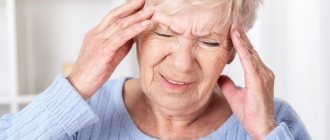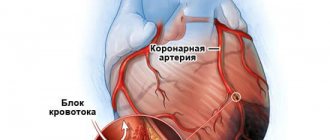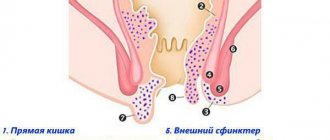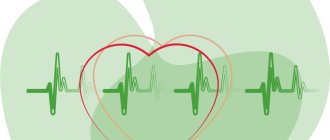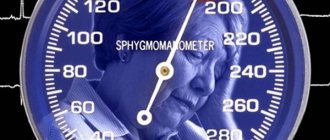People suffering from vegetative-vascular dystonia often complain of feeling unwell, pressure changes, palpitations and even panic attacks. It seems that the body is in constant tension and cannot relax. Various sedatives and antidepressants are used, which, although they have a pronounced therapeutic effect, however, act gradually and gently.
And this is where alcohol comes to the rescue. It’s not for nothing that they say that alcohol perfectly “relieves stress” and “helps you relax.” However, unfortunately, this is not the only effect of ethyl alcohol on the body.
Content:
- What symptoms do patients with VSD experience?
- Where does vegetative-vascular dystonia come from?
- Alcohol with VSD
- Alcohol intoxication with VSD
- Alcoholism with VSD
- Hangover with VSD
- How is alcoholism treated in a patient with vegetative-vascular dystonia?
Vegetovascular dystonia (VSD) is a set of complaints and symptoms that occur in a patient from time to time. Violations can affect the functioning of internal organs and lead to negative mental changes.
In the international classifications of diseases it will not be possible to find the diagnosis “VSD” - it is not there. By this concept, doctors mean a kind of “assembly” of painful symptoms. But statistics show that many people experience similar syndromes.
You cannot drink alcohol if you have vegetative-vascular dystonia. Alcohol aggravates the patient’s condition and creates conditions for the progression of emerging anomalies.
The concept of VSD
This term usually refers not to a disease, but to a complex of symptoms, the appearance of which is associated with disturbances in the functioning of internal organs. The main cause of VSD, according to doctors, is the frantic pace of modern life, hence constant stress and overwork, which “hit” the nervous system.
Signs of dystonia can also result from:
- gastrointestinal diseases;
- problems with the central nervous system;
- emotional instability;
- genetic predisposition;
- alcohol abuse, smoking and other bad habits;
- depressive states, regular stress, other forms of psycho-emotional experiences.
Attention! Neuroses are the main “triggers” that contribute to the occurrence of symptoms of VSD. Any chronic diseases only aggravate the course of dystonia, which arose due to problems with the nervous system.
What symptoms do patients with VSD experience?
The most common complaints concern:
- unstable emotional state, neuroses, depression;
- blood pressure surges;
- hormonal imbalance;
- endocrine disorders;
- pain in the heart.
Patients with VSD often note that their heart beats very fast, their palms sweat, and they feel dizzy. Their blood pressure rises and falls. Fingers tremble uncontrollably.
The level of vital energy drops. There is often a feeling of a lump in the throat. Then it becomes difficult to breathe and swallow. Hiccups, cramps, flatulence, pain of any localization - all these are also manifestations of VSD, and alcohol always intensifies such symptoms.
Panic attacks and alcohol
The occurrence of panic attacks is a serious pathological consequence of alcohol intake by dystonics. This term is used by doctors to describe a sudden deterioration in health, which is accompanied by: sharp jumps in blood pressure, lightheadedness, nausea, trembling, numbness, weakness of the arms and legs, rapid heartbeat, fever, and a feeling of constriction in the throat.
Doctors say that panic attacks are “faithful companions” of residents of megacities suffering from VSD. Some patients try to stop an attack with alcohol - in this case, ethanol can sooner or later cause pathological changes at the psychoneurological level.
You can “recognize” a panic attack by physiological, cognitive-emotional, and behavioral manifestations. The first list includes:
- tachycardia;
- dyspnea;
- feeling of squeezing in the chest;
- increased sweating;
- frequent urination;
- visual aura;
- muscle tension;
- dizziness.
Patients are haunted by anxiety, concern for their own life and health, they find it difficult to think, concentrate , and make informed decisions. Dystonics suffer from insomnia and avoid situations that could cause attacks of fear.
Alcohol during VSD and panic attacks leads to the fact that an intoxicated person cannot sit in one place, constantly moves, and tries to perform certain actions (most often unconscious). Numbness of the limbs, a tingling sensation in the back of the head are “faithful” companions of such pathological conditions.
Where does vegetative-vascular dystonia come from?
The symptom complex negatively affects a person’s life - it reduces its quality. Many people do not understand why it occurs in them. Possible reasons include:
- hypoxia during intrauterine development of the fetus;
- head injuries received by a child during natural childbirth;
- severe infectious and viral diseases suffered in the first year of life.
Under the influence of these factors, the somatic and autonomic nervous system is formed incorrectly. As a result, children suffer from frequent regurgitation, painful colic, insomnia, and decreased immunity.
During adolescence, their internal organs grow faster than stable neuroendocrine regulation is established. Then they make themselves known:
- heartache;
- blood pressure changes;
- asthenia;
- high level of anxiety;
- impairment of cognitive functions (attention, thinking, memory).
According to statistics, from 12 to 29% of children of primary school and adolescence experience manifestations of vegetative-vascular dystonia. In adults, the symptom complex occurs in response to:
- exacerbation of chronic diseases;
- severe stress;
- received traumatic brain injuries;
- endocrine disorders;
- depression;
- hormonal imbalances.
It has been noted that people with a genetic predisposition to VSD experience this syndrome more often than others.
Considering the above, it becomes clear that it is almost impossible to determine the origins of vegetative-vascular dystonia. After all, the disorder usually has its roots in the period of intrauterine development or the first year of a person’s life.
Vegetovascular dystonia and ethanol
How do the concepts of VSD and alcohol relate: it has been scientifically proven that alcoholic drinks not only aggravate the course, but also initially provoke the development of this syndrome.
Despite the fact that autonomic disorders are not fatal and do not pose a direct threat to human health, exacerbation of VSD after alcohol can cause a serious blow to the body. Doctors say that alcohol is the main “provocateur” of panic attacks and other “faithful companions” of dystonic patients. It doesn’t matter what kind of alcohol gets into the blood - beer, vodka, cognac - the well-being of the “victim” of VSD will suffer in any case. At the same time, the dystonic person cannot even get “well drunk” - a hangover in such people develops rapidly and when consuming minimal “dosages” of alcohol.
To clearly demonstrate how detrimental ethanol affects the body of a patient with autonomic disorders, it is enough to measure blood pressure and pulse immediately before and 6-7 hours after drinking alcoholic beverages.
Attention! For most dystonics, 40-50 ml of vodka or any other alcohol causes an immediate jump in blood pressure and an increase in heart rate (by 100-150%).
Alcohol with VSD
Alcohol-containing drinks aggravate the course of vegetative-vascular dystonia, so if you suspect the presence of this disease, you should not drink. Ethyl alcohol molecules change metabolic processes and contribute to enzymatic failures. This makes the person feel even worse.
In drunken patients with VSD, the following are often recorded:
- phobias;
- panic attacks;
- severe pain syndrome of unknown origin.
Doctors are confident that the health of alcohol addicts with VSD is at risk. Treatment of such people is always more complex and lengthy. It begins only after a comprehensive diagnosis, which allows us to understand which internal organs have begun to work incorrectly or not at full capacity.
What happens if you drink more?
In large doses, ethyl alcohol greatly increases blood pressure. Moreover, this is most pronounced as alcohol is metabolized and eliminated from the body. The so-called hangover syndrome begins, which is characterized by:
- Increased blood pressure;
- Tachycardia;
- Dry skin and mucous membranes;
- Severe headaches;
- Hand tremors.
Patients suffering from VSD are at risk and may well suffer a heart attack or stroke due to withdrawal symptoms.
It is also necessary to remember that alcohol inhibits the inhibition processes in the brain, so after taking even small doses, a feeling of euphoria and lightness arises. An insatiable desire to prolong this state appears, and it becomes very difficult for the patient to refuse the next glass of alcohol.
Alcohol intoxication with VSD
Patients with vegetative-vascular dystonia who have consumed large amounts of alcohol run the risk of encountering:
- diarrhea, severe hiccups, vomiting;
- pain symptoms;
- fainting;
- hypertensive crisis.
They are prone to nervous disorders, hysteria, and unbridled aggression. They lose the ability to control their own behavior even after drinking one or two glasses of vodka.
This increased sensitivity to alcohol has a negative impact on your physical and mental well-being. It often results in life-threatening complications. Sobering up with VSD occurs more slowly, so you have to suffer from the symptoms of ethanol intoxication longer.
VSD and alcohol: what changes occur in the body
In people with vegetoneurosis, ethyl alcohol aggravates neurocirculatory disorder. Dangerous syndromes develop that can lead to serious complications. Symptoms begin to actively appear 5–6 hours after the feast.
Characteristics of syndromes:
- Cardialgic.
Chest pain and discomfort, increased weakness and fatigue. - Tachycardic.
The heart rhythm is disturbed, the feeling of heat and tremors of the limbs are disturbing. Often there is a sharp jump in blood pressure by 20–30 mmHg. Art. even with slight intoxication. - Bradycardic.
Blood pressure drops sharply, weakness, dizziness, nausea appear, and coordination is impaired. - Arrhythmic.
Blood pressure increases, pulse quickens, breathing slows. A person feels a lump in the throat, a lack of oxygen. - Psychoneurotic.
Unreasonable anxiety, fear, unstable psycho-emotional state.
To get rid of dysregulation of the ANS (vegetative-vascular system), it is necessary to completely stop smoking and drinking alcoholic beverages.
Alcohol and hypotonic form of VSD
Ethanol dilates blood vessels, blood pressure rises. Additionally, your mood improves and you feel more energetic. But all positive changes are temporary. Therefore, with the hypotonic form of the disease, it is allowed to drink alcohol no more than 1-2 times a week, no more than 100 ml. You must first consult with your doctor.
When drinking alcohol excessively, people with hypotension experience heart pain, migraines, and irritability.
A hangover is accompanied by tremors, loss of strength, and nausea.
Alcoholism with VSD
Alcohol dependence against the background of vegetative-vascular dystonia occurs with complications. The patient quickly moves from one stage of drunkenness to another. Because of this, he is more likely to degrade and experience his first binges.
The prognosis for alcoholism complicated by VSD is unfavorable. Already at the first stages of dependence, dystonic patients encounter psychosis , “delirium tremens.” Such patients need to be treated in a drug treatment hospital. Home therapy for alcohol addiction is usually contraindicated for them due to the large number of risks.
General hangover symptoms
When alcohol breaks down in the body, acetaldehyde is formed. A hangover syndrome is poisoning by the breakdown products of alcohol. With excessive alcohol consumption, the main burden falls on the liver. The organ cannot quickly cope with toxins, and they accumulate in the body.
Not only internal organs are affected, but also the nervous system. The psyche and some parts of the brain also suffer. The most striking are the physiological symptoms of a hangover. They appear:
- frequent urge to urinate;
- febrile state (chills give way to fever);
- severe nausea and vomiting;
- intense sweating;
- numbness of the upper and lower extremities, convulsions;
- drowsiness and lethargy during the day and insomnia at night;
- migraine, dizziness, loss of consciousness.
From the cardiovascular system, tachycardia, surges in blood pressure, and chest pain are observed. Alcohol poisoning also affects a person’s mental state. Most often, deviations from the norm manifest themselves as follows: hallucinations appear, a person is overcome by unreasonable fears, panic attacks, and thoughts of suicide arise. It is also very difficult for the patient to concentrate on something; he is tormented by vague anxiety and guilt, and an obsession with persecution appears.
How is alcoholism treated in a patient with vegetative-vascular dystonia?
Therapy for alcohol poisoning and chronic alcoholism that has developed against the background of VSD is not much different from the standard one. It includes:
- Carrying out detoxification measures. The patient is placed in a drug hospital, where he is given cleansing drips. Physiotherapy is used to enhance infusion therapy. In severe cases, hardware blood purification is connected. But, as a rule, it is possible to obtain the desired result with the help of droppers alone. They include absorbent drugs, glucose, hepatoprotectors, and water-electrolyte solutions. After the first infusion, the patient begins to feel better.
- Pharmacological correction. Before prescribing medications to improve the functioning of internal organs, narcologists conduct diagnostics. Alcohol addicts undergo blood and urine tests, undergo CT scans, ultrasound scans, and consult with specialists. Based on the results of the study, the doctor prescribes the necessary medications.
- Psychotherapy session. Needed to increase motivation for sobriety. In order for a patient with VSD to completely give up alcohol, he must have a strong commitment to recovery. Psychologists and psychotherapists help to form it. Experts are finding out what prompted him to drink alcohol regularly. Additionally, large-scale work is carried out with identified psychosomatic disorders.
- Coding. Today, encoding is carried out using medication, psychotherapy and hardware. With vegetative-vascular dystonia, it is not always possible to use coding medications. For example, they are not suitable if the addict has an inflamed liver or there are serious disruptions in the gastrointestinal tract. Therefore, with this syndrome, hypnosis or Dovzhenko’s stress therapy is often used. Both practices involve deep work with the subconscious. The patient is instilled with a negative attitude towards drinking and everything connected with it. In this case, there is absolutely no need to administer any medications.
- Rehabilitation. Necessary for successful adaptation to a sober lifestyle. When working with patients with VSD, doctors pay special attention to stabilizing the functions of internal organs. It is important that the patient feels well. Otherwise, he will not be able to experience the delights of a sober life and, most likely, will relapse. During the rehabilitation process, the alcohol addict attends sessions of individual and group psychotherapy and maintains constant contact with a psychologist.
Alcoholism and vegetative-vascular dystonia are diseases that can be cured. The most important thing is not to ignore dangerous signs and start therapy as early as possible. Then the craving for drinking, as well as unpleasant symptoms of unknown origin, will disappear forever.
Vegetovascular dystonia (VSD) is a companion to alcoholism
In the modern world, people are increasingly suffering from vegetative-vascular dystonia. This disease begins in children at a fairly early age. Of course, VSD proceeds completely differently. For example, some people don’t notice it at all, while others cannot get out of bed due to pressure. This article should help determine the causes of the disease, symptoms, choice of doctors and, of course, popular advice that you can resort to to slightly delay the time of visiting specialists.
So, first of all, you need to deal with the symptoms of VSD , because knowing them, you will always be ready.
1. Sudden changes in blood pressure , sometimes accompanied by dizziness, headaches and fainting.
2. Increased heart rate ( tachycardia ) or, less commonly, slow heart rate.
3. Unpleasant sensations in the left side of the chest.
4. Sudden lack of clean air.
5. Nausea , sometimes accompanied by vomiting, bloating, diarrhea, constipation, heartburn.
6. High temperature, increased sweating , chills.
7. Strong emotional experiences.
8. Bad dream.
9. Poor performance, lack of concentration on activities.
10. Edema of the extremities.
Most likely, many have encountered similar symptoms, but there is no need to diagnose yourself and run to the pharmacy for pills. If you are still sure that you have vegetative-vascular dystonia, you need to understand its causes.
1. Hormones.
It is problems with hormonal levels that cause VSD. This may be adolescence, pregnancy or breastfeeding. There is no need to be afraid of this, because this is just, so to speak, a restructuring of the body in a new way.
2. Stress and nervousness .
If your life is accompanied by endless waste of nerves and many stressful situations, then you should not be surprised by the appearance of VSD.
3. Moral or physical fatigue.
In everything you need to know when to stop and not try to “catch the bull by the horns.” Rest is also important, so taking a thirty-minute break from your physical or emotional workload won't hurt.
Alcoholism and drug addiction.
Who would have thought that alcohol and drugs cause not only problems with the liver, moral and physical health, but also the appearance of VSD.
It is important to understand that all drugs and alcoholic drinks affect the nervous system, and therefore VSD and a bunch of other diseases develop.
Before treating VSD, you must first treat alcoholism and drug addiction .
5. Chronic diseases.
Severe injuries and illnesses can cause the appearance of vegetative-vascular dystonia, which will play a bad joke for a person.
6. Result of the disease.
Vegetative-vascular dystonia can appear in a person after he has suffered trauma, infection or intoxication.
7. Endocrine system.
It is no secret that everything in our body is interconnected, so problems with the endocrine system are accompanied by VSD.
8. Time zone.
When traveling, people may experience some symptoms of VSD due to the fact that the climate zone and time zone change, the body is rebuilt.
9. Heredity.
In some cases, vegetative-vascular dystonia occurs in a person due to his genetics.
10. Environmental problems.
Currently, the world has big and serious environmental problems. These troubles lead to “receiving” VSD.
After information about the symptoms and causes has been studied, it is worth moving on to treatment.
1. Of course, the first thing that is recommended to do is to reduce stressful moments, sleep and relax more. Every day you should wake up with a positive attitude and look at the world only from the best side. If you cannot achieve some kind of harmony at home, you can seek help and advice from a psychologist. You should also walk more in the fresh air, and valerian, motherwort and chamomile tea are perfect ways to eliminate anxiety and worries. By the way, it is not recommended to forget about rational and proper nutrition, which excludes all possible harmful and unhealthy foods.
2. An excellent way not only to treat VSD, but also to relax is massage and hot baths. This will help you “let off steam,” reduce fatigue, and increase strength and positive emotions.
3. Don't forget about physical activity. No, we are not talking about unloading cars, you should just engage in sports that will bring you pleasure. For example, sports or Nordic walking, basketball, football, tennis, swimming, skating and much more. After all, we all remember: movement is life. Most often, when treating adults, drug treatment is used. Usually prescribed are adrenergic blockers, antidepressants and tranquilizers. However, you should not take them without consulting your doctor.
4. Elimination of bad habits. If you continue or, otherwise, start drinking alcohol, drugs, or simply smoking, this will only worsen the situation. Close people, specialized organizations and simple willpower will help you get rid of addiction.
5. For some types of VSD, it is recommended to drink strong tea, coffee, and take vitamins. To find out your type of vegetative-vascular dystonia, you should consult a doctor as soon as possible.
There are several folk ways to combat vegetative-vascular dystonia
1. Drink valerian twenty-five to thirty drops a day.
2. Drink motherwort tincture one to four times a day, thirty-five to forty drops.
3. It is recommended to drink peony tincture fifteen minutes before main meals, thirty to thirty-five drops. A decoction of Chinese lemongrass, taken one tablespoon before meals, can perfectly help with the hypotonic form of VSD.
4. Ginseng also helps well, the root tincture of which should be taken twenty to thirty drops a day.
5. Also a good remedy is tincture of lure, which can be taken twenty-five to thirty drops up to three times a day.
In conclusion of the article, I would like to note that the treatment of any disease should be accompanied by the advice of the attending physician, because it is impossible to determine the disease by symptoms. We must not forget that all problems come from nerves, therefore, for any ailment, the best medicines are healthy sleep, a friendly atmosphere and support, as well as a change of environment will perfectly help you alleviate the situation at least a little! Do not be ill!
How to help the body?
An intense attack of fear, accompanied by somatic reactions, negatively affects the patient. Therefore, you definitely need to know what to do if you have panic attacks after drinking alcohol. This problem can be solved in several ways.
Fast detoxification
The body will recover on its own in about 2-3 days. A number of simple steps will help speed up this process and significantly reduce the risk of developing panic attacks.
The patient will need:
- Replenish your supply of vitamins. This is best done using IVs or intramuscular injections. If this is not possible, vitamins in tablet form are also suitable.
- Actively cleanse the body. Increase your consumption of mineral water. It is also useful to drink tea with honey, berry fruit drinks and compotes. The recommended daily volume of fluid for a hangover is from 2.5 to 3 liters.
- Connect medications. Pharmacies sell many drugs for hangover syndrome (Limontar, AlkaSeltzer, Pohmelin, etc.). Before use, please read the instructions.
- Cold and hot shower. It will help you cheer up and restore your muscles to their former tone. Alcohol metabolites are also excreted through the upper layer of the epidermis.
A doctor's consultation is required. The specialist will select effective drugs. Panic attacks can be controlled with antidepressants and tranquilizers. You cannot take them without permission.
Breathing exercises
They will help you fight anxiety without medications. This is the simplest thing a person can do in case of intense manifestation of fear.
At the first sign of an attack, you can try the following exercises:
- Belly breathing. Squat down, leaning your back on something stable. Close your eyes, relax, take a slow and deep breath. Hold your breath for 3-4 seconds, exhale slowly. Repeat about 4-5 times.
- Palm breathing. Starting position, as in the first case. Fold your palms into a boat and press them to your mouth and nose. Do the exercise 3-4 times.
- Breathing with a paper bag. The principle is the same. The palms are replaced with a package.
These exercises will help normalize the level of carbon dioxide in the blood and also prevent it from becoming too quickly saturated with oxygen. This will help you calm down.

